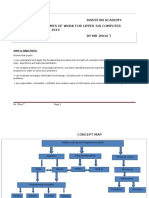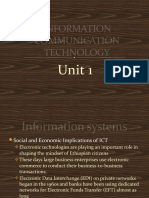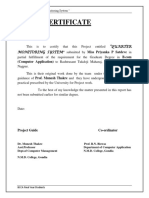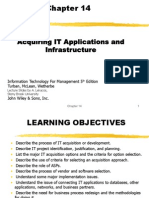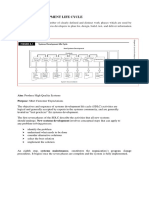ROCKLANDS HIGH SCHOOL
Scheme of Work
HIGH SCHOOL TERM 2, 2025®
COMPUTER SCIENCE- FORM 2
MRS ZHAKATA E
�Aims & Assessment objectives
Aims
The aims are to enable students to develop:
• computational thinking skills
• an understanding of the main principles of solving problems using computers
• an understanding of the component parts of computer systems and how they interrelate
• an understanding of the internet as a means of communication and its associated risks
• an understanding of the development and use of automated and emerging technologies.
Assessment objectives
The assessment objectives (AOs) are:
AO1: Recall, select and communicate knowledge and understanding of computer technology
AO2: Apply knowledge, understanding and skills to solve computing or programming problems
AO3: Analyse, evaluate, make reasoned judgements and present conclusions
Topic Suggested teaching time (hours / % of the course)
MRS ZHAKATA E
�1 Algorithm design and problem solving 24 hours 16% of the course.
3 Programming concepts 10 hours 7% of the course.
4 Database 8 hours/ 6% of the course.
MRS ZHAKATA E
�Week Topic/ Learning Competencies Teacher/Pupil Activities SOC Media
End Content objectives
Week 1 7 Algorithm Lesson 1 Collaborative learning Intro: Syllabus Code: 0478
design and - Define and The teacher to introduce the lesson by asking what a system is.
problem solving explain the Students to give real life examples of system that includes the IGCSE Programming course book
program Pg 11
Point-of-Sale System.
development
SDLC life cycle: Activities:
analysis, Teacher introduction to the program development life Week
design, including:
coding and analysis – identification, abstraction, decomposition
testing. of the problem and identification of requirements
- design – shown by decomposition using structure
diagrams, flowcharts and pseudocode
coding – writing program code and performing
iterative testing
testing – testing program code using test data
Concl: Learners to wrap up the lesson by giving brief
description of the stages of SDLC.
Week 1 Lesson 2 Group discussion Intro: Syllabus Code: 0478
Students to summarise on the concepts learnt in the previous
-Understand that every lesson (outline all the SDLC stages in order) IGCSE Programming course book
computer system is made Pg 16
Activities:
up of sub-systems, which
are made up of further Class brainstorms a non-computer system to show that it is
sub-systems. comprised of sub-systems.
-Understand how a Learners analyse a relevant and appropriate system to identify
problem can be sub-systems, and to sub-divide these. This could be the academic
decomposed into its or personnel structure of a school/college, a department store, a
component parts. Use large company, etc. Structure diagrams can be used to document
different methods to
this. (I)
design and construct a
solution to a problem.
Concl:
Slow learners to summarise the lesson, and teacher to take of the
areas they need help during remedials.
Week 1 7 Algorithm Lesson 3 Peer teaching Intro: Syllabus Code: 0478 Whiteboard
design and Students to recap the previous lesson Desktop
problem solving - show Group discussion on Main Activities: IGCSE Programming course book computers
understanding various operators used in Laptop computers
Teacher introduces:
of good programming Pg 21 projector
Variable names variable the use of variable names and mapping of values (e.g.
Operators names x ← 3 means the value 3 is written as the new value
MRS ZHAKATA E
� - Assignment stored in the memory location labelled x, x ← y
and proper means the value stored in the memory location
use of labelled y is copied to the memory location labelled
operators and
x)
how the
symbols use of mathematical operators including +, -, *, /,^,
differ from MOD and DIV
mathematics. use of logical operators including =, <, >=, <=, >, and
<>
use of Boolean operators including AND, OR and
NOT
Concl: Students to summarise on concepts learnt.
Week 2 Lesson 1 -Learners to work in Intro: Syllabus Code: 0478 Whiteboard
7 Algorithm pairs Students to recap the previous lesson With a diagram
design and Main Activities: IGCSE Programming course book illustrating a
problem solving -Explain the purpose of a flowchart to be
Learners carry out analysis of prepared flowcharts to work out
given algorithm Pg 23 converted to
the purpose and the processes involved. The pseudocode
difficulty/complexity of the flowchart can be increased to make
it more challenging where necessary. (I)
Learners carry out analysis of prepared pseudocode to work out
the purpose and the processes involved. (I) The
difficulty/complexity of the pseudocode can be increased to
make it more challenging where necessary.
Learners answer previous exam/textbook questions on the
program lifeWeek and sub systems. (F)
Concl: Students to summarise on concepts learnt.
Week 2 7 Algorithm Lesson 2 Collaborative learning Intro: Projector
design and Students to explain how they come up with the purpose of an Syllabus Code: 0478 displaying an
problem solving Understand standard algorithm summarily. algorithm on
methods of solution. IGCSE Programming course book the wall.
Activities:
Teacher demonstrates standard methods of solution that can be Pg 26
used in solving many different problems including:
linear search and bubble sort
totalling and counting
finding maximum, minimum and average values
Concl: Useful introductory videos:
Linear search
MRS ZHAKATA E
� Learners identify the standard methods of solution shown in https://www.youtube.com/watch?
teacher prepared flowcharts and pseudocode algorithms. v=PDE8pCQ9Tz4
Learners complete further gapped handouts showing the Bubble sort
standard methods of solution. (I) https://www.youtube.com/watch?
v=JP5KkzdUEYI
Week 2 7 Algorithm Lesson 3 Presentation Intro: Syllabus Code: 0478 Laptops and
Lesson 3 design and Teacher explains need for validation checks to prevent input of desktops with MS
problem solving Understand the need for incorrect data; teacher provides list of common applications (e.g. IGCSE Programming course book Access in
validation checks to be checking data
car registrations, test marks, learner names, temperatures,
made on input data and Notes, quizzes and activities for during data entry
the different types of salaries) and learners identify possible validation rules.
data validation:
validation check. Activities:
www.teach-ict.com/
Teacher adds those that the class has not identified (need to
gcse_computing/ocr/databases/
cover range checks, length checks, type checks, presence checks,
validating/home_validating.htm
format checks and check digits).
www.klbict.co.uk/gcse/theory/
Teacher demonstrates introduction of validation checks with
5_3/5_3_3_valid_verif.htm
decision boxes in a sample flowchart; learners add validation to
existing flowcharts.
Calculation of check digits using ISBN (for example) by teacher
demonstration and learner completion of a selection provided.
Concl:
Learners who did not present in the lesson are asked to
summarise the concepts learnt.
Week 3 7 Algorithm Lesson 1 Individual work Students to write concept test individually Syllabus Code: 0478
design and
problem solving -To be able to answer IGCSE Programming course book
extracted past exam
MayJune 2021 Paper 21 Qn 2,3
MayJune 2021 paper 22 Qn2,3
Week 3 7 Algorithm Lesson 2 Peers teaching Teacher to pick students who scored low marks to lead in the Syllabus Code: 0478
design and revision.
problem solving -To be able to relate High fliers to peer teach low performers. IGCSE Programming course book
written answers with
After every question, the teacher will summarise using the
answers from peers MayJune 2021 Paper 21 Qn 2,3 and
proper subject jargon. mark scheme
MayJune 2021 paper 22 Qn2,3 and
mark scheme
Week 3 7 Algorithm Lesson 3 Presentation Intro: Syllabus Code: 0478 Laptops and
design and Recap of the previous concepts: teacher to pick out students who desktops with MS
problem solving -Understand the need for did not present on the previous lesson. IGCSE Programming course book Access in
verification checks to be checking data
Activities:
made on input data and Notes, quizzes and activities for during data entry
the different types of Brainstorm the importance of verification when data is
data validation:
verification check. transferred between media (design flowchart for double entry of
www.teach-ict.com/
e.g. password).
MRS ZHAKATA E
� Teacher how verification would take place including visual gcse_computing/ocr/databases/
checks and double entry. validating/home_validating.htm
Teacher demonstrates introduction of verification checks with www.klbict.co.uk/gcse/theory/
extra pseudocode in a sample algorithm; learners add 5_3/5_3_3_valid_verif.htm
verification to existing pseudocode algorithms.
Week 4 7 Algorithm Lesson 1 Problem-based learning Intro: Syllabus Code: 0478 Images of test
design and The teacher to introduce the concept by giving a scenario based cases.
problem solving Suggest and apply proble, and ask students to decompose the problem into smaller IGCSE Programming course book
suitable test data.
manageable units.
March 2019 Paper 22, question 2,
Activities: question 3 and question 5
Brainstorm to consider the limits for input data in any system; June 2019 Paper 21, question 4
identify possible different types of input data (normal, boundary, June 2019 Paper 22, question 2,
extreme and abnormal/erroneous). question 3 and question 5
Learners identify examples of each type for a range of given
situations, as test data. (I)
Concl:
Teacher to randomly pick covered questions and randomly ask
learners to give answers.
Week 4 7 Algorithm Lesson 2 Scenario-based learning Intro: Syllabus Code: 0478 Projector
design and Teacher demonstrates design and completion of trace table for displaying
problem solving -Complete a trace table dry runs of a simple flowchart. IGCSE Programming course book algorithms on the
to document a dry-run of wall to be traced.
an algorithms. March 2020 Paper 22, question 2,
question 3 and question 5
Activities: June 2021 Paper 21, question 4
Learners carry out exercise on flowcharts (opportunity for June 2020 Paper 22, question 2,
differentiation by complexity of flowchart). question 3 and question 5
Teacher demonstrates design and completion of trace table for
dry runs of a simple pseudocode algorithm. Learners carry out
exercise on pseudocode algorithms (opportunity for
differentiation by complexity of algorithm). (I)(F)
Learners use trace tables to analyse flowcharts for incorrect
algorithms and identify the source of the errors.(I)
Concl:
Students to summarise the concepts learnt.
Week 4 7 Algorithm Lesson 3 Class discusion Learners should perform practical exercises to demonstrate Syllabus Code: 0478 Projector showing
MRS ZHAKATA E
� design and solution design such as: algorithms where
problem solving -Identify and suggest finding the average of a set of input numbers IGCSE Programming course book errors are to
ways of correcting of finding largest and smallest numbers in a set of input identified.
errors in algorithms. Nov 2019 Paper 23, question 5 and
numbers calculating the frequency distribution of
question 6
ranges of numbers in a set of input numbers (e.g. March 2020 Paper 22 question 2,
when a series of temperatures T are input, how many question 3 and question 4
are in each of the ranges -20 T < 0, 0 T < 20 and June 2020 Paper 21, question 2,
20 T < 40?) (I) question 3, question 4 and question
5
Week 5 7 Algorithm Lesson 1 Case based Learning Intro: Syllabus Code: 0478 Projector showing
design and Teacher to display on the projector a question and ask students algorithms with
problem solving Write and amend Activities: IGCSE Programming course book errors that needs
algorithms for given to be ammended.
Using a simple algorithm, represented as a paragraph of English
problems or scenarios Learners practice using the IDE
using, pseudocode, or as a flowchart, learners convert this to pseudocode. Simple
with simple programs e.g. ‘Hello
program code and examples could be numerical problems such addition,
World’ (I)
flowcharts. subtraction, multiplication, division; more challenging examples
Tutorials for various programming
could be set in the real world, such as the use of an ATM. (I)
languages:
www.codecademy.com/learn
These could be followed by case studies and questions. For
example, an automatic supermarket stock control system for
calculating stock levels and automatically re-ordering items. (I)
Concl:
Teacher to select three students who were not participating
actively in class to summarise the lesson.
Week 5 8.1 Programming Lesson 2 Class discusion Intro: Syllabus Code: 0478 Laptops and
concepts Teacher introduces concepts of constants and variables; desktops with
1 Declare and use brainstorm to identify basic data types. IGCSE Programming course book IDEs
variables and
Learners practice using the IDE
constants. Activities:
with simple programs e.g. ‘Hello
2 Understand and use Learners obtain definitions of data types (integer, real, char,
World’ (I)
basic data types. string and Boolean) from web research.
Tutorials for various programming
3 Understand and use Theory notes on data types:
languages:
input and output. www.teach-ict.com/gcse_computing/ocr/216_programming/
www.codecademy.com/learn
handling_data/home_handling_data.htm
Class brainstorm to revise use of:
variable names, assignment commands (←)
mathematical operators including +, -, *, /,^, MOD
and DIV
logical operators including =, <, >=, <=, >, and <>,
Boolean operators including AND, OR and NOT
MRS ZHAKATA E
� Teacher revisits pseudocode for:
input and output (e.g. READ and PRINT)
selection using conditional statements IF … THEN
… ELSE … ENDIF, CASE OF … OTHERWISE …
ENDCASE
iteration with count-controlled loops FOR … NEXT,
pre-condition loops DO WHILE … ENDWHILE and
post-condition loops REPEAT … UNTIL
counting and totalling
Week 5 7 Programming Lesson 3 Individual work Students to write concept test individually Syllabus Code: 0478
Concepts -To be able to answer
extracted past exam IGCSE Programming course book
March 2019 Paper 22, question 1
and question 4
June 2019 Paper 21, question 1,
question 2 and question 3
June 2019 Paper 22, question 1 and
question 4
June 2019 Paper 23, question 1 and
question 5
Week 7 7 Programming Lesson 1 Peers teaching Teacher to pick students who scored low marks to lead in the Syllabus Code: 0478
concepts -To be able to relate revision.
written answers with High fliers to peer teach low performers. IGCSE Programming course book
answers from peers After every question, the teacher will summarise using the
March 2019 Paper 22, question 1
proper subject jargon. and question 4
June 2019 Paper 21, question 1,
question 2 and question 3
June 2019 Paper 22, question 1 and
question 4
June 2019 Paper 23, question 1 and
question 5 and their mark schemes.
MRS ZHAKATA E






